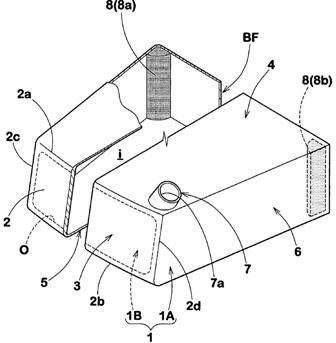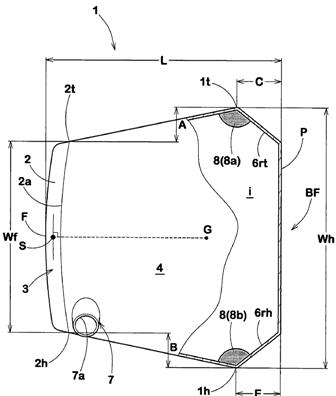Furyk’s New Srixon Driver?
We have heard all about Furyk’s never ending search for the perfect new driver. In fact, I have heard too much about it. Well, this week a SRI patent issued that may give us a look at the next one we see in his bag, or not. Check out this beauty!
The drawings come from USPN 7,682,263 titled “Golf Club Head,” which explains:
My prediction is that we won’t be seeing this one on Tour anytime soon.
Dave Dawsey - Monitoring Golf Patent Applications
PS – check out additional “interesting” golf club designs HERE
The drawings come from USPN 7,682,263 titled “Golf Club Head,” which explains:
The present invention relates to a golf club head, more particularly to a hollow structure having a specific shape capable of increasing the depth of center of gravity and the moment of inertia of the head.
It is effectual for improving the directionality of a hit ball to deepen the center of gravity of the head and to increase the moment of inertia. By increasing the depth of the center of gravity, the club face is increased in the sweet spot area and as a result the average carry distance can be increased. By increasing the moment of inertia, movements of the head caused by the counter-reaction to hitting of a ball is decreased, and the directionality can be improved.
Conventionally, driver or wood golf clubs have pear-shaped heads as shown in FIG. 10. Nowadays, in order to increase the moment of inertia and to deepen the center of gravity, very large-sized metal wood heads and metal/FRP hybrid wood heads are marketed. Even in such large-sized current heads, the shapes are pear-shapes, following a tradition.
In the case of pear-shaped heads, when obtaining a deep center of gravity and an increased moment of inertia, a certain degree of increase of the head volume and a certain degree of increase of the head weight are inevitable. As a result, the head speed during swing tends to decrease. As the head volume increases, a weight margin available for adjusting the position of the center of gravity is decreased, therefore, the flexibility of designing the weight distribution is lost. As a result, it becomes difficult to increase the depth of the center of gravity.
.
.
.
DESCRIPTION OF THE PREFERRED EMBODIMENTS
In the drawings, golf club head 1 according to the present invention comprises: a face portion 3 whose front face defines a club face 2 for striking a ball; a crown portion 4 intersecting the club face 2 at the upper edge 2a thereof; a sole portion 5 intersecting the club face 2 at the lower edge 2b thereof; a side portion 6 between the crown portion 4 and sole portion 5 which extends from a toe-side edge 2c to a heel-side edge 2d of the club face 2 through the back face BF of the head; and a hosel portion 7 at the heel side end of the crown to be attached to an end of a club shaft (not shown) inserted into the shaft inserting hole 7a. Thus, the head 1 is provided with a hollow structure with the thin wall. The hollow (i) in this example is a closed void space, but it may be filled with a foamed plastic, leaving a space from the backside of the face portion 3.
The golf club head 1 in this example is made up of two metal components: an open-front hollow main component 1A and a face component 1B closing the opening O of the main component 1A. It is of course possible that the head is made up of three or more components.
In order to increase the head volume without increasing the head weight, the specific gravity of the main component 1A is preferably in a range of not more than 4.6, more preferably not more than 4.0, still more preferably not more than 3.0, but not less than 1.0 in view of the strength and durability.
In order to reduce the weight of the face portion while maintaining the sufficient strength, the specific gravity of the face component 1B is preferably in a range of not less than 2.0, more preferably not less than 3.0, still more preferably not less than 4.0, but, not more than 6.0, more preferably not more than 5.5, still more preferably not more than 5.0.
For examples, titanium, titanium alloys, stainless steel alloys, maraging steels, magnesium alloys, aluminum alloys and the like can be used as the materials of the main component 1A and face component 1B. Such components are formed by forging, casting, press molding and the like, and connected with each other by welding and the like. Incidentally, fiber reinforced resins may be used, for example as a part of the main component 1A.
In the case that the head 1 is for a driver, the head volume is preferably set in a range of not less than 350 cc, more preferably not less than 400 cc, still more preferably not less than 450 cc to increase the depth of the center of gravity and the moment of inertia of the head. However, to prevent an excessive increase in the head weight and deteriorations of swing balance and durability and further in view of golf rules or regulations, the head volume is set in a range of not more than 460 cc.
The weight of the head 1 is preferably set in a range of not less than 170 grams, more preferably not less than 177 grams, still more preferably not less than 184 grams in view of the swing balance and rebound performance, but not more than 220 grams, more preferably not more than 210 grams in view of the directionality and traveling distance of the ball.
If the head is too small in the back-and-forth direction FB, the depth of the center G of gravity becomes shallow. If too large, it becomes difficult to conform to the golf rules or regulations. Therefore, the maximum length L of the head in the back-and-forth direction FB is set in a range of not less than 80 mm, preferably not less than 90 mm, more preferably not less than 100 mm, but not more than 122 mm, preferably not more than 120 mm, more preferably not more than 115 mm.
If the height T of the club face 2 is too small, the carry distance and directionality of the hit ball are liable to become unstable. If the height T is too large, as the head volume can not be too large, the maximum length L of the head tends to become small and as a result, it becomes difficult to increase the depth of the center of gravity. Therefore, the height T of the club face 2 is preferably set in a range of not less than 35 mm, more preferably not less than 38 mm, still more preferably not less than 40 mm, but not more than 55 mm, more preferably not more than 50 mm, still more preferably not more than 48 mm.
If the maximum width Wf of the club face is too small, the carry distance and directionality of the hit ball are liable to become unstable. If the maximum width Wf is too large, it becomes difficult to secure the necessary club face height T. Therefore, the maximum width Wf of the club face is preferably set in a range of not less than 80 mm, more preferably not less than 90 mm, still more preferably not less than 100 mm, but, not more than 120 mm, more preferably not more than 115 mm, still more preferably not more than 110 mm.
In the plan view of the head, namely, when viewed from above the head, the width of the head measured in the heel-and-toe direction is gradually increased from the face portion towards the back face BF. This increase in the width can be regarded as a result of an increase occurring on the toe-side and an increase occurring on the heel-side, and as shown in FIGS. 3, 6 and 7, the maximum A of the increase occurring on the toe-side and the maximum B of the increase occurring on the heel-side are preferably set in a range of not less than 5 mm, more preferably not less than 10 mm, but, not more than 20 mm, more preferably not more than 15 mm. If the maximum increases A and B are less than 5 mm, it is difficult to increase the moment of inertia and the depth of the center of gravity of the head. If the maximum increases A and B are more than 20 mm, the shape of the head becomes extraordinary and it is difficult to use.
My prediction is that we won’t be seeing this one on Tour anytime soon.
Dave Dawsey - Monitoring Golf Patent Applications
PS – check out additional “interesting” golf club designs HERE





Comments